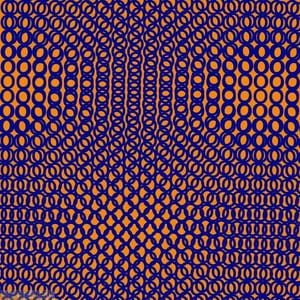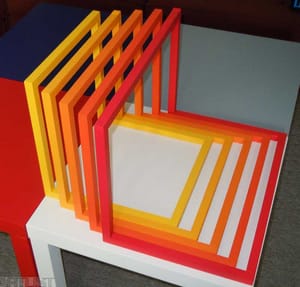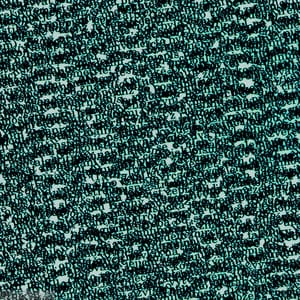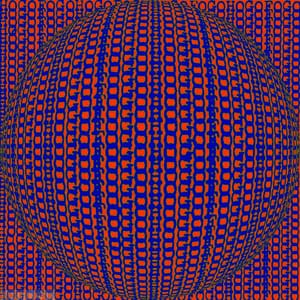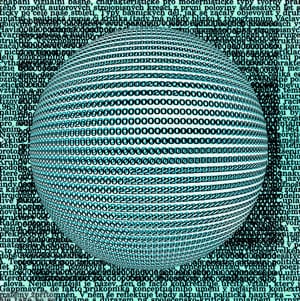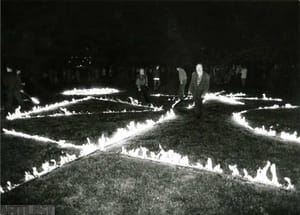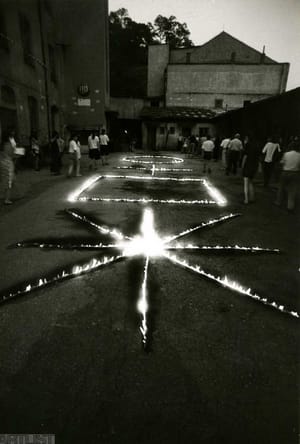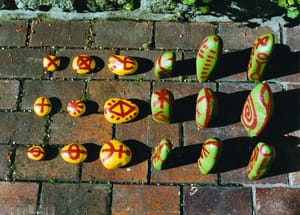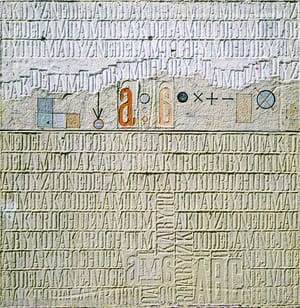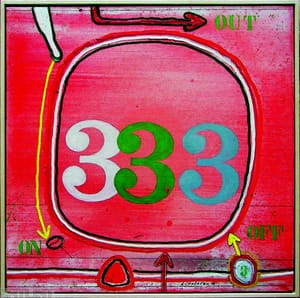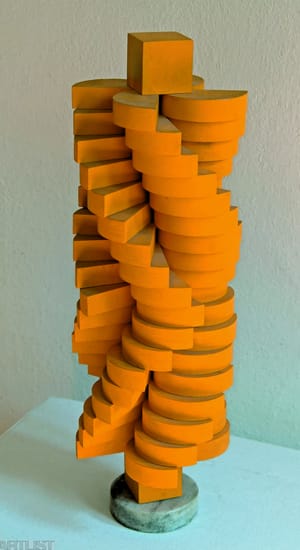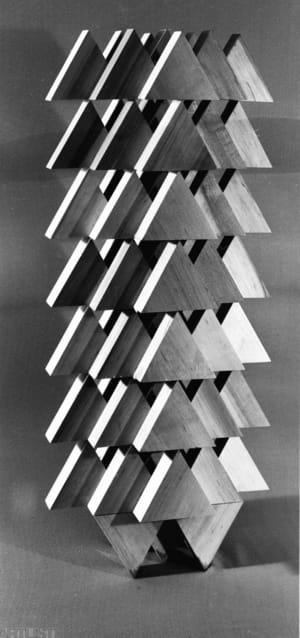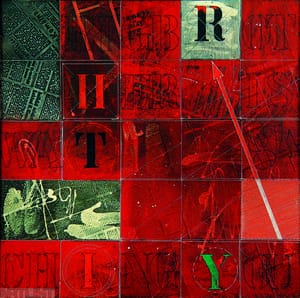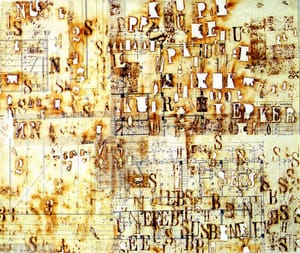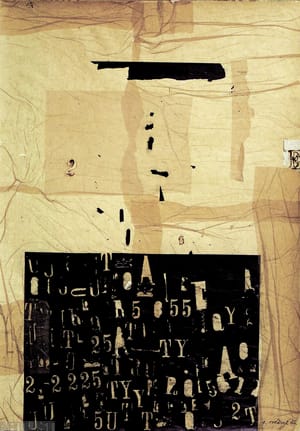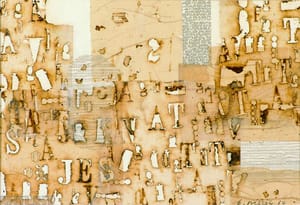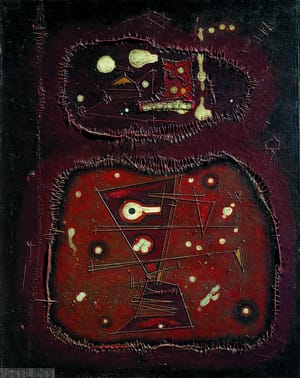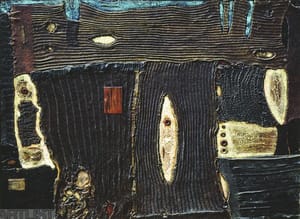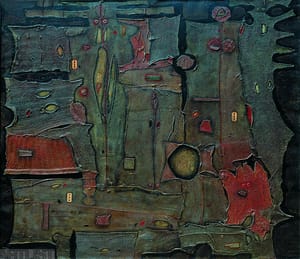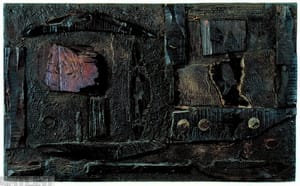- First Name
- Eduard
- Surname
- Ovčáček
- Born
- 1933
- Birth place
- Třinec
- Place of work
- Ostrava
- Website
- www.eduardovcacek.cz
- CSU Library
- ↳ Find in the catalogue
About artist
There appears to be no sphere of art that Eduard Ovčáček has not turned his hand to. His extraordinarily diverse work is based on constant experimentation with forms. However, he retains a hallmark style as well as the main symbol that has appeared in multiple variations right from the start, namely the letter. He was trained as a painter. Over the next few years he was engaged to a varying extent in graphic design, photography, illustration, lettrist poetry, objects, and in the 1990s with land art and installations.
His story begins in Ostrava, where he lived, and Bratislava, where he studied. His figural paintings from the latter half of the 1950s display heightened stylisation of zoomorphic and anthropomorphic motifs. He seeks inspiration in the work of Joan Miró and Paul Klee, and this is manifest in the deliberately childlike form of expression to be found in Dvě ženy / Two Women (1959). From his earliest paintings onwards, Ovčáček does not quit the flat surface or attempt to create 3-dimensional space through paint.
Around this time he also began to take an interest in the work of Vladimír Boudník, whom he met in person in 1960 and whose work influenced him to such an extent that he began to work with structural graphics in the series Deflorace / Defloration (1961). Later he would create Deníky / Journals, Manifesty / Manifestos, and a cycle of circular graphic designs (all in 1964). Since then abstraction has become his main means of expression. Unlike his creative model, he began to include pictograms, letters and numerals in his designs. People, who had figured in his early paintings, suddenly disappeared to be replaced by graphemes that for Ovčáček were a symbol of human communication. The symbol was not an isolated unit but represented humankind and its existence. During the 1960s, his interest in the currents of thought of that time, especially existentialism, led to paintings created in the spirit of informel. In the series Epitafy / Epitaphs he used dark colours and a density of structure, supported by dipping textiles and other objects in the surface paint.
Though Ovčáček created most of his work on his own, albeit with a feel for his surroundings, in 1961 he initiated Confrontations in Bratislava (these exhibitions were held every year until 1964), which introduced non-figurative tendencies in the work of Slovak and Czech artists. Boudník was present in spirit, having sent a graphic design and a greetings letter.
The 1960s in Czechoslovakia played host to several artistic interests, including constructivism and lettrism, which Ovčáček devoted himself to. Thanks to his fascination with experimental poetry, in 1961–1962 a Phonetic Dictionary was created based on the phonetic-semantic play of words, and a year later he created his typographic poems, the cycle Kolotoče / Carousel and Den královny Alžběty / Queen Elizabeth’s Day. In the same year he exhibited for the first time abroad at a group exhibition in Warsaw. In 1966 he took part in a major Prague exhibition entitled Obraz a písmo / Image and Letter that included international participation.
Ovčáček’s work from the 1960s features burnt reliefs, statues and spatial décollages. Jiří Valoch attributed a unique position in relation to world art to these statues, and Ludmila Vachtová prizes them above all the rest of Ovčáček’s output, partly because, in contrast to informel or structural graphics (albeit decorated with letters), no one else was working in a similar way at that time. His wooden objects of 1965 such as Stereograms, Metaphors, Era or No nic / It’s Nothing are raw evidence of human civilisation that give the impression of being exhibits from an ethnographic museum and resemble ancient artefacts, a sense heightened by their being placed on metal poles. An important element is the rhythm of the letters that are burned into the wood in a brutal fashion. Even here, however, the main role is taken by the surface of the objects rather than their shape.
In the latter half of the 1960s, under the influence of constructivism, Ovčáček’s objects were aestheticised and the rhythm of the symbols replaced by stereometric elements. These also become the focal point in the work of the members of the Concretism Club, of which Ovčáček was a founding member. His objects, though highly thought of, were a deviation within the broader context of his work, although he never fully rejected the third dimension and in 1969–1970 created several paintings in which he included electronics or machine components.
During the 1970s and 80s the human figure returned to his work. Formerly it had been represented on a symbolic level by a symbol, letter or as initiator of components that in turn became part of the painting. Now it returned in a form that can only be described as grotesque. Mangled, gurning, sometimes comical figures or rather caricatures full of sarcasm and exaggeration. After several years Ovčáček yet again proved that he was mainly interested in finding new paths, as yet unexplored. He used handmade paper instead of canvas, and pastel tones instead of the rich colours typical of his informel period. What he had sought in his work with material he included in a relief-based processing of the surface that handmade paper permitted him.
In contrast, during the 1990s he created ephemeral actions with no emphasis on the final product. This includes the works Archetypální znaky / Archetypal Symbols and Zastavený čas / Stopped Time of 1994, in which the main role is taken by fire, the element that had fascinated during the 1990s when he had burned letters and numbers into paper or wood. Ovčáček’s return to painting was close to op-art. Using simple colour compositions and the repetition of a symbol or single element, e.g. circle, he created compositions that worked with the visual impression of 3-dimensional space and vibration.
- Author of the annotation
- Zuzana Krišková
- Published
- 2018
CV
Studia: 1957–1963 VŠVU Bratislava (prof. Peter Matějka) 1961 VŠUP Praha (prof. Antonín Kybal) Zaměstnání: 1963–1968 odb. asistent grafických technik, FF-výtvarná výchova, Palackého univerzita Olomouc 1991–2007 docent Katedry výtvarné tvorby, později Fakulta umění, Ostravská univerzita 2000–2013 profesor, vedoucí Katedry grafiky a kresby na Fakultě umění, Ostravská univerzita
Exhibitions
- Solo exhibitions
-
Selection:
2013
Again & diferently, Topič Salon Company, Prague
Ovčáček !!!, The Gallery of Fine Arts in Ostrava
Archiv médií, Slovácké muzeum v Uherském Hradišti – Czech Rep.
Galerie města Třince, Digitální grafika 2003 – 2013 – Czech Rep.
Oevres graphiques, Musée de l' Imprimerie, Lyon - France
2012
Last Decade, City Gallery of Blansko
Eduard Ovčáček & Miloš Urbásek, Závodný Gallery, Mikulov
Metamorphoses of Media 1960-2012, Miloš Alexander Bazovský Gallery in Trenčín
A Glance, Kampa Museum, Prague
2010
Odadozet, Rondo Sztuki, Katowice – Poland
2009
Communication in Writing & Image, The Olomouc Museum of Art
Letterstory, Galerie de la Maison Pierre Werner, Luxembourg – Luxembourg
The Art Centre Chagall, Gallery of the Czech Photography, Ostrava
2008
Aspects of the Geometry of Writing and Signs, The Art Gallery in Nové Zámky
Metamorphoses – Five Spaces, Five Media, Turiec Gallery in Martin
2007
Peripeteia of Writing and Signs, Smečky Gallery smečky, Prague
2006
Serigraphy & Digital Graphic Arts, Hollar Gallery, Prague
2005
Selected works of 1959–2005, The Regional Gallery in Liberec
2001
The Retrospection 1959–2000, The State Gallery in Banská Bystrica
2001
Eduard Ovčáček in Ostrava Region, The Gallery of Fine Arts in Ostrava
2000
Serigraphy 1968–1999, The City Gallery of Bratislava, Pálffy Palace
1999
Exhibition of the Laureate of Vladimír Boudník Award, Old Town Hall in Prague
The Retrospective Exhibition 1959–1999, The Czech Museum of Fine Arts, Prague
1997
Von der informellen Kunst zum Lettrismus, Tschechisches Zentrum, Berlín – Germany
1995
Eduard Ovčáček, Galerie im Rathaus Tempelhof, Berlin – Germany
1993
Eduard Ovčáček, Centrum Sztuki v Bytomiu – Poland
1993
Selected works by E.Ovčáček, The State Gallery in Zlín (nowadays The Regional Gallery of Fine Arts)
1991
Fronta Gallery in Prague
1989
Eduard Ovčáček, Gluri Suter Huus, Wettingen – Schwitzerland
1981
Eduard Ovčáček, Galerie Pragxis, Essen – Germany
1967
Eduard Ovčáček, The Gallery of Fine Arts in Ostrava
1966
Eduard Ovčáček, The Charles Square Gallery
Monography
- Monography
Monografie, knihy (výběr): Barrie Tullett: Typewriter Art. A Modern Anthology, Laurence King Publishers, London 2014 Florence Jaillet, Jiří Machalický: Oeuvres Graphiques, Musée de l'imprimerie, Lyon 2013 Ludvík Ševeček a kolektiv autorů: OVČÁČEK!!! (katalog k výstavě v GVU Ostrava), 2013 Jan Matoušek, Markéta Vinglerová, Vladimír 518: M = M (Město=Médium), Bigg Boss (VŠUP), Praha, 2012 – CZ / Jan Matoušek, Markéta Vinglerová, Vladimír 518: M = M (City=Medium), Bigg Boss (Academy of Arts, Architecture and Design), Prague 2012 Antonín Dufek: V plném spektru (Fotografie 1841–2005 ze sbírky Moravské galerie v Brně), Kant, Praha 2011 – CZ / Antonín Dufek: Full Spectrum (Fifty Years of Collecting Photography), Moravian Gallery in Brno & Kant Publishers, Prague 2011 Juraj Mojžiš a Sabina Jankovičová: Bratislavské konfrontácie, Petum s.r.o, Bratislava 2010 – SK / Juraj Mojžiš a Sabina Jankovičová: Bratislava Confrontations, Petum Publishers, Bratislava 2010 – Sk Luba Belohradská, Eva Trojanová: Hranice geometrie (Geometrické a konstruktivní tendence ve slovenském výtvarném umění), Petum s.r.o., Bratislava 2009 – SK / Luba Belohradská, Eva Trojanová: The Botders of Geometry (Geometric and Constructive Tendencies in Slovak Visual Arts), Petum Publishers, Bratislava 2009 – SK Simona Racková a kol.: Antologie české poezie I. díl. (1966–2006), Dybbuk, Praha 2009 – CZ / Simona Racková and collective: Anthology of Czech Poetry– Part I (1966–2006), Dybbuk Publishers, Prague 2009 Vom Sammeln und von Freundschaften (Künstlermappen KonkreterKun – Michaela Riese Stifftung. Texte von Eva Demski und Hans-Peter Riese), Wienand Verlag 2008 – D / Jiří Valoch, Jiří Machalický, Juraj Mojžiš: EDUARD OVČÁČEK - MONOGRAFIE (Tvorba z let 1965–2006), Gallery, Praha 2007 – CZ / Jiří Valoch, Jiří Machalický, Juraj Mojžiš: EDUARD OVČÁČEK (Works from 1965–2006), Gallery Publishers, Prague 2007 Z. Böhnerová, I. Jančar: Slovenská grafika 20. storočia, Galéria mesta Bratislavy, 2007 – SK / Z. Böhnerová, I. Jančar: Slovak Graphic Arts of the 20th Century, City Gallery of Bratislava, 2007 – SK Jarosław Denisiuk: Otwarta galeria (Formy przestrzenne w Elblągu. Przewodnik), Centrum Sztuki Galeria EL w Elblągu, 2006 – PL / Jarosław Denisiuk: Open Gallery (Spatial forms in Elbląg. Guidebook), Centrum Sztuki Galeria EL w Elblągu, 2006 – PL České ateliéry, Art CZ, Praha 2005 – CZ / The Czech Studios, Art CZ, Prague 2005 V. Birgus, J. Mlčoch: Česká fotografie 20. století, Kant, Praha 2005 – CZ / V. Birgus, J. Mlčoch: Czech Photography of the 20th Century, Kant, Prague 2005 Zdeněk Primus: Umění je abstrakce (Česká vizuální kultura 60. let), Kant, Praha 2003 – CZ / Zdeněk Primus: Art is an Abstraction (Czech Visual Culture of the Sixties), Kant Publishers, Prague 2003 Eduard Ovčáček: Tetovaná žena (Fotografie), Střelec, Praha 2002 – CZ / Eduard Ovčáček: A Tattooed Woman (Photographies), Střelec Publishers, Prague 2002 Eduard Ovčáček: SLOVAZNOVASLOVA (Poezie), Střelec, Praha 2000 – CZ / Eduard Ovčáček: WORDS-AGAIN-WORDS (Poetry), Střelec Publishers, Prague 2000 20. storočie – Dejiny slovenského výtvarného umenia, Slovenská národná galéria v Bratislave, 2000 – SK / 20th Century – The History of the Slovak Visual Art, Slovak National Gallery in Bratislava, 2000 – SK Jan Kříž: EDUARD OVČÁČEK (Tvorba z let 1959–1999), České muzeum výtvarných umění, Praha a Gema Art, Praha 1999 – CZ / Jan Kříž: EDUARD OVČÁČEK (Works from 1959–1999), The Czech Museum of Fine Arts, Prague & Gema Art Publishers, Prague 1999 Mahulena Nešlehová: Poselství jiného výrazu (Pojetí informelu v českém umění), Base-ART et Fact, Praha 1997 – CZ / The Legacy of a Different Expression (The Concept of Informel in the Czech Art), Base-ART et Fact, Prague 1997 Slovník svetového a slovenského výtvarného umenia druhej polovice 20. storočia, Profil, Bratislava 1999 – SK The Encyclopedia of the World and Slovak Visual Art of the Second Half of the 20th Century, Profil Publishers, Bratislava 1999 – SK Alena Potůčková, Ivan Neumann, Olaf Hanel, Jiří Šetlík: Umění zastaveného času (Česká výtvarná scéna 1969–1985), České muzeum výtvarných umění, Praha 1996 – CZ / Alena Potůčková, Ivan Neumann, Olaf Hanel, Jiří Šetlík: The Art of the Stopped Time (Czech Visual Art Scene 1969–1985), The Czech Museum of Fine Arts, Prague 1996 Eduard Ovčáček: Lekce velkého A (Konkrétní a vizuální poezie 1962–1993, texty: Arsén Pohribný a Jiří Valoch), Trigon, Praha 1995 – CZ / Eduard Ovčáček: The Lesson of a Big A (Concrete and Visual Poetry 1962–1993, texts: Arsén Pohribný and Jiří Valoch), Trigon Publishers, Prague 1995 Šesťdesiate, Slovenská národná galéria v Bratislave, 1995 – SK / The Sixtieth Anniversary, Slovak National Gallery in Bratislava, 1995 – SK Marie Klimešová-Judlová: Ohniska znovuzrození (České umění 1956–1963), Galerie hl. města Prahy a Ústav dějin umění Akademie věd ČR, 1994 – CZ / Marie Klimešová-Judlová: The Sources of Regeneration (Czech Art 1956–1963), City Gallery of Prague & Institute of Art History, Academy of Sciences of the Czech Republic, 1994 Jindřich Chalupecký: Nové umění v Čechách, H&H, Praha 1994 – CZ / Jindřich Chalupecký: New Art in Bohemia, H&H, Prague 1994 Encyklopedie českých a slovenských fotografů, Asco, Praha 1993 – CZ /
